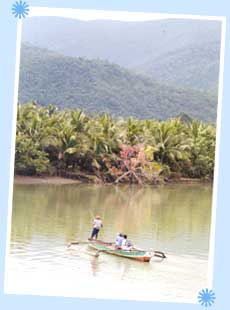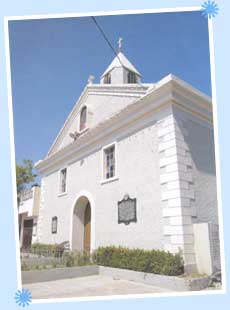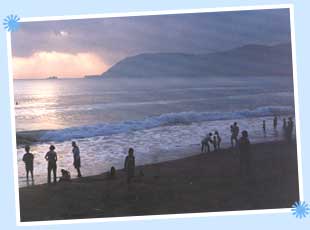Introduction
Baler For All Time
by Edgardo J. Angara
A place is as precious as its treasury of memories, and a hometown becomes special because of all the fragments of happenstance history that one associates with it.
As a son of Baler, I take pride in a hometown fabled for its wealth of associations-including the lore and the legend that have given it a unique character and flavor. Only Baler can be Baler. Fortuitous have been the threads of fate that have gone into the weaving of its historical tapestry.
Baler's remote location-its relative isolation on the narrow east coast of Luzon, on the seaward slope of the Sierra Madres - is part of what makes it distinct: part of what makes my hometown what it was, what it is today, and what it will be or all time.
A great part of our provincial course of study is devoted to teaching our young people the history and cultural heritage of Aurora Province and of the Filipino nation. Through the Museo de Baler, which opened in 2003, the provincial government also promotes pride in Aurora's cultural and historical heritage.
One notable exhibition was devoted to the life and career of Manuel L. Quezon, Baler's foremost son, the nationalist leader of the American period who became the first president of the Philippines. Another highlighted one of Aurora's indigenous peoples, the Ilongot. The Museo preserves Ilongot as well as Dumagat artifacts, mementoes, and historical records dating back to the Spanish period.
Baler was the last bastion of the Spanish Empire in the Philippines. On 27 June 1898, 15 days after Filipino revolutionists had proclaimed their country's independence, 54 Spanish soldiers of the Baler garrison barricaded themselves in the town church and endured a siege by the revolutionary forces for almost a full year, before the survivors gave themselves up on 2 June 1899.
By then, Spain had ceded the archipelago to the United States. The Revolutionary Government, although by then fighting for its very survival against the Americans, took the time and the effort to pay tribute to loyalty, courage, and gallantry of the Spanish defenders of Baler. President Emilio Aguinaldo ordered them treated not as prisoners of war but as worthy adversaries, and ensured their safe passage home.

Every 30th of June since 2003, I have invited the descendants of the Spanish survivors of that siege to visit Baler to commemorate with us what has become an exemplary narrative manifesting the best of human traits in a time of conflict: courage, resolve, gallantry, and nobility.
These are the same qualities that up to now form our special ties with Spain, under whose tutelage we first learned to appreciate the benefits of history, to look back to our past for moral strength and heroic inspiration.
During this last decade, I have sought to rekindle he warmth of the relations our two peoples enjoyed for the most part of over three centuries. I have traveled to many towns in Spain to seek out he descendants of Los Ultimos de Filipinos, "the last detail" in the Spanish Army's effort to put down the Philippine revolution against Spain. In holding out against all odds, Los Ultimos showed the world, including our own young nation, the indomitable character of the Spanish soldiery. Perhaps even more important, they evoked from their Filipino adversaries the gallantry that warfare at its most noble sometimes called into being.
I have also visited with their descendants in Spain, who until now look back proudly to the heroism of their forebears, and who remain grateful for the opportunity that their stationing in the Philippines gave them to show the steel in their mettle as Spanish soldiers.
Members of their families welcomed me into their homes. They were as pleased as we were over the proclamation by an Act of Congress of Philippine-Spanish Friendship Day, which was first celebrated in 2003. Since then, they have come to take part in the festivities in Baler on the last day of June.
In the last days of June 2005, a distinguished group of visitors from many parts of Spain came to Baler to share our celebration of Philippine- Spanish Friendship Day. This year, officials from both Madrid and the local governments were on hand to reaffirm the ties between our two countries and to see for themselves the town that, for their forebears, represented a home and a hearth to be defended at all costs in the name of Spain.
The Spanish delegation, led by Senator Francisco Balla Galan of Almonte, included mayors and councilors of the Spanish towns, among them Huelva, Mula, Puebla del Don Fabrique, and Miajadas-from which the men of the Baler garrison had come. It also included Fernando Martin Cerezo, a colonel in the Spanish Air Force who was the grandson and namesake of Lieutenant Martin Cerezo, the commanding officer of the Baler garrison.
It was Lieutenant Cerezo who had kept a journal of his wartime experiences and of his troop's fortitude during the yearlong siege-an account published as a book called El Sitio de Baler. Translated into English by an American military officer, the account has become a training manual on endurance and survival by the United States Army. It also became the first of many publications and celebratory chronicles - including songs and films - with which most every Spaniard becomes familiar while growing up.

When our Spanish guests walked the streets of Baler last June, it felt like homecoming for many of them. We brought our guests to the Sitio Castillo, the old stone watchtower that, during the Spanish times, had guarded our town against Ilongot marauders from the mountainous north, as well as Moro raiders from the Pacific seacoast. Our Spanish friends also took part in. unveiling the Dikaloyungan marker that recalls the vow of Baler's Katipuneros-through a blood compact in 1897-to fight for the Revolution; they also sat enthralled as students presented a theater-piece that dramatized events of the long siege.
At the Museo de Baler, Spaniards and Filipinos together cut the ceremonial ribbon to open an extensive exhibit of splendid photographs by professional photographers from Manila, covering the images of Baler and the rest of our province of Aurora that are specimens of timelessness. These images found a fitting venue, since the museum, which houses mementoes of Baler's cultural heritage and serves as a testimony of our unbreakable ties with Spain, was inaugurated on the occasion of the first celebration of Philippine- Spanish Friendship Day on June 30,2003.
There are plans to upgrade and enhance the museum, and it is a project that will be undertaken by the offices of Aurora Governor Bellaflor Angara-Castillo and Baler Mayor Arthur Angara, in partnership with the heirs of the survivors of the historic siege, the National Historical Institute, the National Museum, and my own office.
Among the exhibits being installed to attract more visitors is an interactive display. The ethnological and anthropological exhibits in place are constantly being enlarged and improved. All these projects should ensure that the museum represents adequately the culture and history of Baler and the local diversity of Aurora province and should continue to promote relations between Philippines and Spain.
In 2006 the Philippine-Spanish Friendship Day was celebrated in Palencia, Spain, to honor its son Fray Miguel de Benavides, founder of the University of Santo Tomas, the oldest university in Asia. The festivities culminated with the signing of a sisterhood agreement between the president of Palencia, Spain, and Governor Bellaflor Angara-Castillo of Aurora, Philippines. At the same time, Palencia honored both Governor Angara-Castillo and myself by making us its Adopted Daughter and Son.
The Early History of Baler
Baler's very existence may be traced to the exploits of the early Spanish adventurers for whom the known world was but a stepping stone to strange lands that awaited, not simply conquest, but discovery. Clearly, those early Spaniards were seduced just as much by the romance of exploration as by the glory of empire-building. And it was their expeditions that gave birth to places of timelessness, such as our own Baler.
In 1572, the conquistador Juan de Salcedo, exploring northwestern Luzon, crossed the Cordillera ranges and came down Luzon's eastern coast to the edge of the Pacific Ocean. He became the first European to set foot on the virgin region that would eventually become Aurora. Salcedo apparently traveled through the lovely forested regions that would become the towns of Casiguran, Baler, and Infanta.

Along the trails now charted came the bearers of the Cross, following the conquerors. The Aurora region was assigned to the Franciscans. The first Franciscan missionary to arrive, Fray Esteban Ortiz, was recorded to have set foot in Luzon in 1578. He was known to have quickly started proselytizing in the forested areas and the coastal strip facing the Pacific Ocean.
In July 1609, Fray Blas Palomino led six other Franciscans in a tedious crossing of the Sierra Madre to reach a Christian community by the Pacific coast that would eventually be named Baler. The village was located at the wide open end of a horseshoe bend shaped by a river running down the Caraballo mountain.
The Franciscan friars must have marveled at the physical environment in which they found themselves. On a landward side, the tiny settlement was protected by the Sierra Madre and the Caraballo mountain. On the seaward side stretched the vast Pacific, with its shore extending north and south. A tidal stream surrounded settlement's huts, some of which were built right on the delta, while others were perched on elevated land. Four waterways bounded the settlement. Agwang, since renamed San Jose River, flowed towards the north, while the Kinalapan River flowed southwards. Duongan flowed eastward to the bay; to the west of the poblacion (town) was Suklayin Creek.
The site of the settlement was well selected and benefited from its proximity to both mountain and sea. Among the inhabitants were farmers, fishermen, and hunters. Eventually they were joined by Christian families that were resettling from the Central Luzon province of Nueva Ecija. In 1609, a barangay (village) government was established under the guidance of Fray Valeriano so that the settlement became the first official poblacion in all of the coastal territory. Two years later, in 1611, under the leadership of Fray Francisco de San Antonio, the Franciscans built Baler's first church of nipa and wood.
How Baler Got Its Name
There are four different versions of how the town got its name. The first involves the simplistic story that an old woman, when asked the name of the place by the Spanish explorers, had thought they asked her name and responded, "Vale." A second version suggests that the place name's origin is the Dumagat word balid, which means "to return," and which the people of the area used to refer to a hunter or food-gatherer coming back from a foray into the nearby mountains. A third version refers to a lakan (nobleman) named Balid who lived in the region before the Spanish coming.
In the absence of historical records, the origin of the name of a place may be too easily conceived, imagined, and garbled. Hence we put more weight on the fourth version, which suggests that the name Baler is taken from balod, which is the indigenous name for the mountain doves or paloma montes that continue to abound the area. This, at any rate, is how the Noceda y Sanlucar Vocabulario of 1860 traces the origin of our capital town's name. By the way, our own Institute of National Language accepts this legend as theory.
The entire coastal region of Aurora was linked ecclesiastically to the southern town of Infanta in the early years of the Spanish period. Infanta would become the biggest municipality in the main district of what was then called Kalilaya, later to become the province of Quezon. As early as 1591, the Spanish authorities had organized Kalilaya district to include large parts of what now make up the provinces of Laguna and Nueva Ecija. In 1701, Nueva Ecija was separated from Kalilaya Province and given its own local government. Around 1749, the provincial capital was in turn transferred from Kalilaya to the southern town of Tayabas. The whole province then took on the name of Tayabas as well.
Ecclesiastically, the region was turned over to the Augustinians and Recollects in 1658, when the vanguard Friars Minor began to lack missionaries to serve the growing population. But the Franciscans regained the territory in 1703, setting up missions in Dipaculao in 1719 and in Casiguran in 1753.
In December 1735, a tromba marina, which we have learned to call a tsunami, hit Baler shortly after midnight, engulfing nearly the entire community. Members of the Angara, Bijasa, Bitong, Carrasco, Lumasac, and Poblete families survived the great waves by scrambling to higher ground together with the parish priest of Casiguran, who had been visiting the town. The survivors swam their way up the hill overlooking Point Baja, now known as Ermita Hill. The neighboring villages of Casiguran, Dipaculao, and Dingalan were spared from the catastrophe.
The Baler community rebuilt its village, with some of the survivors bravely returning to the delta area, which they from then on called kinagunasan-devastated. Others resettled in a new site that eventually became the Baler poblacion.
Another tragedy struck Baler in 1798, when Balangingi pirates sailed from Ticao and Burias in Southern Luzon and raided coastal towns of Tayabas, including Baler. Three Franciscan priests and 450 residents lost their lives.
In 1818, Nueva Ecija annexed the towns of Palanan from the province of Isabela, as well as Baler, Casiguran, Infanta and Polillo Island from Tayabas. Between 1855 and 1885, Aurora, then named Pook El Principe, was declared a comandancia politico- militar, with its capital at Baler.
